Today was a warm, perfectly clear day, notably absent of the fog, cold and wind of the past week…
It seems like September 11 is always a bright, clear day, both here in northern California as well as back in New York. It was certainly a clear day five years ago as well…
There are certainly a lot being written online on this fifth anniverary of 9-11 – some of it genuine (particularly from New Yorkers, though not limited to them), a lot of it propaganda, or phony sentimentality or “patriotism.” I would stay clear of the whole thing if I didn't think I had something unique to contibute…
I begin with quote from this view from the WTC plaza that I read this afternoon:
 I arrived in Lower Manhattan at about 8:38. Walking up Dey Street I decided to stop for coffee and walked across Church Street onto the Plaza of the World Trade Center. I called my father on my cell phone and we were talking which kept me from entering the building. I was on a bench right in front of the WTC 1 and turned slowly for no real reason and saw the entire plane hit the tower. I saw the wing extended from the building on the south side and a large explosion. Then smoke. Then everything was frozen, very still, with a perfect New York blue sky framing the backdrop of explosions. I ran when the glass and metal begin to fall from the sky hitting all around me…At that point I began running north. I got to East 4th Street completely dazed. On Houston St. I saw the WTC 1's needle crumble to the ground and heard on blasting radios that both of the towers had fallen. From there I made my way to the Williamsburg Bridge and made my way back home. Tens of thousands of people were walking across the bridge, a surreal exodus no one was quite prepared to cope with…
I arrived in Lower Manhattan at about 8:38. Walking up Dey Street I decided to stop for coffee and walked across Church Street onto the Plaza of the World Trade Center. I called my father on my cell phone and we were talking which kept me from entering the building. I was on a bench right in front of the WTC 1 and turned slowly for no real reason and saw the entire plane hit the tower. I saw the wing extended from the building on the south side and a large explosion. Then smoke. Then everything was frozen, very still, with a perfect New York blue sky framing the backdrop of explosions. I ran when the glass and metal begin to fall from the sky hitting all around me…At that point I began running north. I got to East 4th Street completely dazed. On Houston St. I saw the WTC 1's needle crumble to the ground and heard on blasting radios that both of the towers had fallen. From there I made my way to the Williamsburg Bridge and made my way back home. Tens of thousands of people were walking across the bridge, a surreal exodus no one was quite prepared to cope with…
I never thought I would work in the World Trade Center. But I enjoyed my work there. Like all artists, I needed the money, but I also made many friends and learned a good deal about other parts of life, other skills that I never knew I possessed.
The views of the harbor were magnificent and inspirational. I remember ending long days by looking out the windows and feeling so very refreshed and glad to be in such a beautiful city like New York.
But that view is gone and so much has changed. Though I have felt such anger and frustration, more that ever in my life, I know I will survive. I made it out alive for a reason.
At the same time, I was 3,000 miles away in the totally boring and pathetic Bay Area town of Fremont, arising from bed an hour or so later to face an ordinary day at work 40 miles away along with daily challenges of my unravelling relationship. That was all, at least temporarily, swept away by what I saw and heard on CNN (only after receiving an email exhorting everyone to turn on the news). I didn't get into work until sometime in the afternoon, and then spent much of the day online looking at photos; I continued to wade through photos well into the night after returning home.
Things like this were not supposed to happen, not to New York, not to its iconic and familiar skyscrapers, not to the indistructable momunments of the modern world. Whether it was during my happy years in Berkeley or the miserable year in Fremont that was only beginning, I'd always be able to go back to New York – and suddenly that was no longer something I could count on, everything was mortal, and I was “guilty” somehow for not being there…
I did make it back to New York in Novemember, 2001, and of course had to see ground zero for myself. This is a photo I took looking into the site, from the north (Varick Street, I think):

In the longer view, the thought I have kept coming back to was the idea that something so beautiful (the World Trade Center complex, the New York City skyline, the emblems of 20th Century modernism) were destroyed by something so ugly (Islamic fundamentalism, the tribal and primitive past). Having not lost anyone personally on 9-11, I am able to think about things like this, and how what I want in return is the restoration of modern ideals. I will leave the political and cultural aspects aside for another post (I'm sure I'll get back to it again), and focus for this anniversary on the aesthetic and architectural.
The Skyscraper Museum in New York, which is hosting a commemoration of what it labels the “original World Trade Center,” lends its support the idea that the age of the vertical metropolis is far from over. In that spirit, the Lower Manhattan Development Corporation (LMDC) unveiled the latest design for the new World Trade Center complex, including the new major buildings and the memorial:

 Having followed the redevelopment story over the past few years, I am used to the new design, and I am mindful of the controversies around the original Twin Towers in the late 1960s as being too “boring” and somehow an affront to New York's skyline, and in the long run nothing could have been further from the truth. The building designs have attracted a certain amount of controversy, but nearly as much as the design for the memorial. Any design certainly has it's imperfections, but as it stands it is perfectly in harmony with the modernism of both the original and new World Trade Center complexes, and it includes the most important generally-agreed-upon elements such as preserving the footprints of the original towers, and even incorporates a piece of the original retaining wall (illustrated in the picture to the right). Certainly, the criticms have their place, notably the concern by 9-11 families for the victims' names. But that's where their “rights” end, at least as far as the restoration is concerned. I mean no disrespect to the people who lost loved ones, but if we followed the advice of some outspoken victims' relatives and the opinions of many unaffected people in Middle America, such as the author of this article (he can't even get his dueling memorial-advocacy websites straight!), lower Manhattan would be overrun with kitch, over-sentimentality and insipid tributes to phoney patrotism. That may be fine for Oklahoma City, but not for New York! It's bad enough that we have to live with middle America's patron saints of mediocrity as our leaders along with their policies that make our great cities targets for more terrorism, let alone have to deal with their ideas of what makes a good memorial…But, I did say I'll save the politics for later. So for now, I leave with with another quote from that original site I references that discusses what not only it's author (Sami Plotkin) but indeed many New Yorkers might have wanted:
Having followed the redevelopment story over the past few years, I am used to the new design, and I am mindful of the controversies around the original Twin Towers in the late 1960s as being too “boring” and somehow an affront to New York's skyline, and in the long run nothing could have been further from the truth. The building designs have attracted a certain amount of controversy, but nearly as much as the design for the memorial. Any design certainly has it's imperfections, but as it stands it is perfectly in harmony with the modernism of both the original and new World Trade Center complexes, and it includes the most important generally-agreed-upon elements such as preserving the footprints of the original towers, and even incorporates a piece of the original retaining wall (illustrated in the picture to the right). Certainly, the criticms have their place, notably the concern by 9-11 families for the victims' names. But that's where their “rights” end, at least as far as the restoration is concerned. I mean no disrespect to the people who lost loved ones, but if we followed the advice of some outspoken victims' relatives and the opinions of many unaffected people in Middle America, such as the author of this article (he can't even get his dueling memorial-advocacy websites straight!), lower Manhattan would be overrun with kitch, over-sentimentality and insipid tributes to phoney patrotism. That may be fine for Oklahoma City, but not for New York! It's bad enough that we have to live with middle America's patron saints of mediocrity as our leaders along with their policies that make our great cities targets for more terrorism, let alone have to deal with their ideas of what makes a good memorial…But, I did say I'll save the politics for later. So for now, I leave with with another quote from that original site I references that discusses what not only it's author (Sami Plotkin) but indeed many New Yorkers might have wanted:
None of us wanted to see [the twisted structure of the 500 foot wall] go. We have been comforted over the past two weeks by its presence. We have marvelled at its strange beauty, as it rose from the ruins, an intricate lacy network of sheer strength; a stoic remnant that survived the blast and struck us with its splendor in the golden light of sunset, as bright rays glanced off the building behind, glinting between its metal beams and through the great accidental window which was rent through at just the right height. It was an image of alarming beauty, and the serendipity of its perfect composition was significant to us. In the most simple and sentimental way, the evening light shining through that accidental window was for us a ray of hope. Although we all understood that for now it must come down, whispered questions eddied through the crowd as we wondered, would the pieces be saved? Does the Mayor know that we have already begun to see this as our monument? For we have. That mangled and beautiful skelet! on was a monument that spoke more poignantly of New York's pain and resilience than any artwork we could have devised.
9-11
September 11
New York
World Trade Center
wtc
memorial
modernism
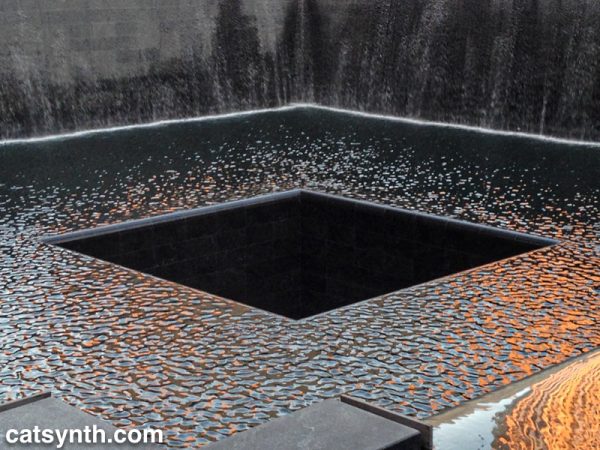
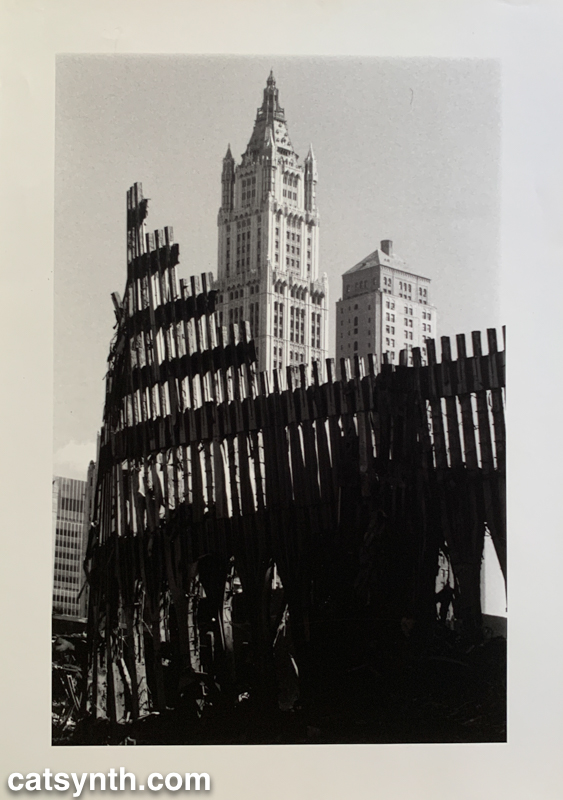

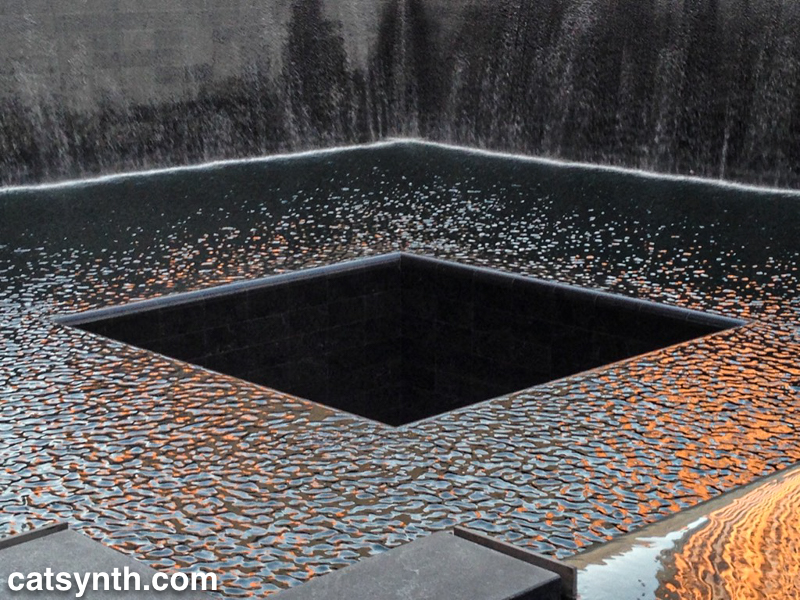
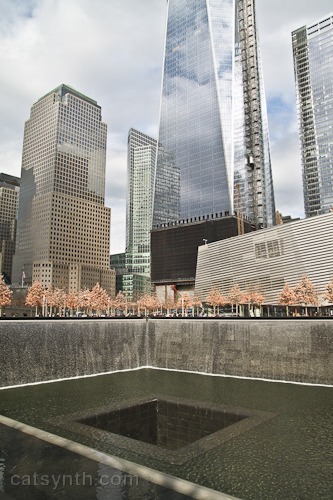
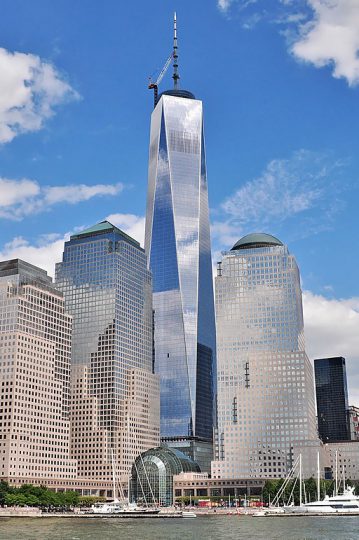
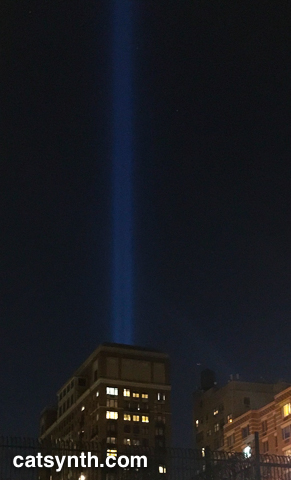













 I arrived in Lower Manhattan at about 8:38. Walking up Dey Street I decided to stop for coffee and walked across Church Street onto the Plaza of the World Trade Center. I called my father on my cell phone and we were talking which kept me from entering the building. I was on a bench right in front of the WTC 1 and turned slowly for no real reason and saw the entire plane hit the tower. I saw the wing extended from the building on the south side and a large explosion. Then smoke. Then everything was frozen, very still, with a perfect New York blue sky framing the backdrop of explosions. I ran when the glass and metal begin to fall from the sky hitting all around me…At that point I began running north. I got to East 4th Street completely dazed. On Houston St. I saw the WTC 1's needle crumble to the ground and heard on blasting radios that both of the towers had fallen. From there I made my way to the Williamsburg Bridge and made my way back home. Tens of thousands of people were walking across the bridge, a surreal exodus no one was quite prepared to cope with…
I arrived in Lower Manhattan at about 8:38. Walking up Dey Street I decided to stop for coffee and walked across Church Street onto the Plaza of the World Trade Center. I called my father on my cell phone and we were talking which kept me from entering the building. I was on a bench right in front of the WTC 1 and turned slowly for no real reason and saw the entire plane hit the tower. I saw the wing extended from the building on the south side and a large explosion. Then smoke. Then everything was frozen, very still, with a perfect New York blue sky framing the backdrop of explosions. I ran when the glass and metal begin to fall from the sky hitting all around me…At that point I began running north. I got to East 4th Street completely dazed. On Houston St. I saw the WTC 1's needle crumble to the ground and heard on blasting radios that both of the towers had fallen. From there I made my way to the Williamsburg Bridge and made my way back home. Tens of thousands of people were walking across the bridge, a surreal exodus no one was quite prepared to cope with…

 Having followed the redevelopment story over the past few years, I am used to the new design, and I am mindful of the controversies around the original Twin Towers in the late 1960s as being too “boring” and somehow an affront to New York's skyline, and in the long run nothing could have been further from the truth. The building designs have attracted a certain amount of controversy, but nearly as much as the design for
Having followed the redevelopment story over the past few years, I am used to the new design, and I am mindful of the controversies around the original Twin Towers in the late 1960s as being too “boring” and somehow an affront to New York's skyline, and in the long run nothing could have been further from the truth. The building designs have attracted a certain amount of controversy, but nearly as much as the design for